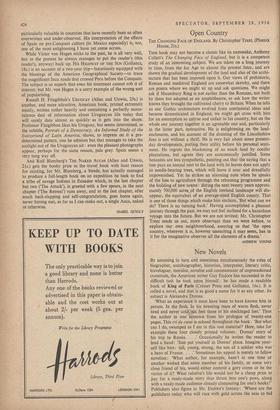Around the World
THE virtuosity of travel writers begins to exceed, though you' might think this impossible with so much space at their disposal, the multiplicity of subjects, and excuses so slender as to be almost invisible now serve to produce stout volumes. The eight in my current batch, all but one concerned with the Spanish—or at least Iberian—outlook, influence, or way of life, however scattered in space, are mostly of the rather slender kind, and as representative a selection as you could find of varying methods, techniques and policies.
To take the exception first: Andrew Shirley's THE LION AND THE LILY (Putnam, 25s.) explores the large slice of France from Le Havre to the Dordogne in so far, as it was 'interfered with' by the English during centuries of our more or less benevolent holding of those parts. Crammed with fascinating little facts, with dozens of brisk and modernising portraits of people in the shadowier corners of medieval history, it is a good example of popularised scholarship; but Mr. Shipley is so excruciatingly facetious, his style contorts itself into such spine-chilling knots, that I spent much of my time with it groaning gently in critical pain..
Gentle groaning is hardly enough for Yves Bottineau's SPAIN (Nicholas Kaye, 30s.); its style deserves yelps of anguish. One of those travel books which, while excellent to look at—the photo- graphs are splendid, and often highly original—are impossible to read, the fault lies less with M. Bottineau, whose French text, though windy and platitudinous, may have read agreeably enough as a very plain guide to the very uninformed, factually minded tourist, than with his translator, whose text reads not unlike those Spanish guides to remote caves or monasteries, com- piled with no more knowledge of English than comes from a dictionary and a sanguine temper. 'Finally, by a vaulted passage- way, we enter the Plaza del Hospital—oh I beautiful vision in its serene harmony! Opposite us the Rajoy so classical and majestic . . .' etc. etc.
Claude Dervenn's THE AZORES (Harrap, 30s.) has the opposite virtues and vices: a text of some charm and interest in a bad piece of book production, with posey and ill-assembled photo- graphs, a general impression of typographical confusion, and the captions written in an extraordinary mixture of French (why on earth?) and English. Mr. Dervenn writes of a personal and enraptured voyage of discovery; and a good many local facts and figures infiltrate into the poetry.
Jay Williams's A CHANGE OF CLIMATE (Macdonald, 15s.) is even more personal, one of those breezy American accounts of domestic ups and downs—in this case, through France and to a summer in Majorca—and in its limited high-spirited way it seems to me a very pleasant' addition to the recent spate of books on holidays on the cheap.
For the most interesting, book of the batch, the only one with a worthwhile theme really adequately treated, 'we must cross the Atlantic to Peter Schmid's BEGGARS ON GOLDEN Sroots (Weiden- feld and Nicolson, 25s.), an account, at once racy, sensitive and highly individual, of a journey through Central and South America. Mr. Schmid's catholic enthusiasm moves easily from archeology to modern politics, from Rivera to Patinos, and his peculiar brand of bold, incisive and humorous observation is
particularly valuable in countries that have recently been so often overwritten and under-observed. His interpretation of the effects of Spain on pre-Conquest culture (in Mexico especially) is, too, one of the most enlightening I have yet come across.
While Victor von Hagen sticks to the past, he is all very well, but in the present he always manages to put the reader's (this reader's, anyway) back up. His HIGHWAY OF THE SUN (Gollancz, 18s.) is an account of a two-year trip—luxuriously equipped with the blessings of the American Geographical Society—to trace the magnificent Inca roads that crossed Peru before the Conquest. The subject is so superb that even his treatment cannot rob it of interest; but Mr. von Hagen is a sorry example of the wrong sort of popularising.
Russell H. Fitzgibbon's URUGUAY (Allen and Unwin, 25s.) is another, and more attractive, American book, printed extremely nastily, written rather heavily and containing a perfectly moun- tainous deal of information about Uruguayan life today that will surely date almost as quickly as it gets into the shops. Professor Fitzgibbon likes his Uruguay, but seems determined, as the subtitle, Portrait of a Democracy, An Informal Study of the Switzerland of Latin America, shows, to impress on it a pre- determined pattern, one he admires but that manages to take the sunlight out of the Uruguayan air : even the pleasant photographs appear, perhaps for the same reason, pale grey. Spain seems a very long way off.
And Rolf Blomberg's THE NAKED AUCAS (Allen and Unwin, 21s.) gets the booby prize as the travel book with least reason for existing, for Mr. Blomberg, a Swede, has actually managed to produce a full-length book on an expedition he took to find a tribe of savage Indians in Ecuador which, in the last chapter but two (The Attack'), is greeted with a few spears, in the next chapter (The Retreat') runs away, and in the last chapter, after much back-slapping and self-congratulation, goes home again, never having met, as far as I can make out, a single Auca, naked or otherwise.
ISABEL QUIGLY



































 Previous page
Previous page